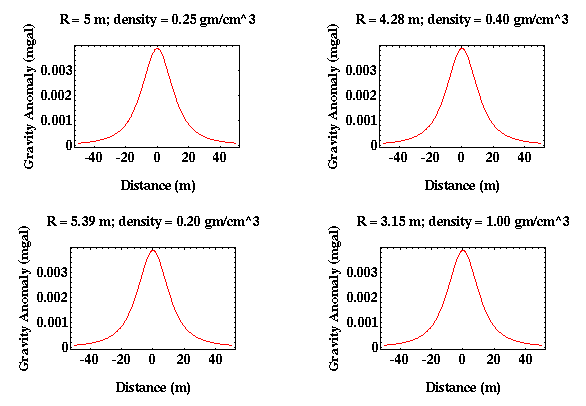Model Indeterminancy
We have now derived the gravitational attraction associated with a simple spherical body. The vertical component of this attraction was shown to be equal to:

Notice that our expression for the gravitational acceleration over a sphere contains a term
that describes the physical parameters of the spherical body; its radius, R, and its
density contrast,  , in the form
, in the form

R and  are two of the parameters
describing the sphere that we would like to
be able to determine from our gravity observations (the third is the depth to the center
of the sphere z). That is, we would like to compute
predicted gravitational accelerations given estimates of R and
are two of the parameters
describing the sphere that we would like to
be able to determine from our gravity observations (the third is the depth to the center
of the sphere z). That is, we would like to compute
predicted gravitational accelerations given estimates of R and
 , compare
these to those that were observed, and then vary R and
, compare
these to those that were observed, and then vary R and  until
the
predicted acceleration matches the observed acceleration.
until
the
predicted acceleration matches the observed acceleration.
This sounds simple enough, but there is a significant problem: there is an infinite number
of combinations of R and  that produce
exactly the same gravitational
acceleration! For example, let's assume that we have found values for
R and
that produce
exactly the same gravitational
acceleration! For example, let's assume that we have found values for
R and  that fit our observations such that
that fit our observations such that

Any other combination of values for R and  will also fit
the observations as
long as R cubed times
will also fit
the observations as
long as R cubed times  equals 31.25.
Examples of the gravity observations produced
by four of these solutions are shown below.
equals 31.25.
Examples of the gravity observations produced
by four of these solutions are shown below.

Our inability to uniquely resolve parameters describing a model of the earth from geophysical observations is not unique to the gravity method but is present in all geophysical methods. This is referred to using a variety of expressions: Model Interminancy, Model Equivalence, and Nonuniqueness to name a few. No matter what it is called, it always means the same thing; a particular geophysical method can not uniquely define the geologic structure underlying the survey. Another way of thinking about this problem is to realize that a model of the geologic structure can uniquely define the gravitational field over the structure. The gravitational field, however, can not uniquely define the geologic structure that produced it.
If this is the case, how do we determine which model is correct? To do this we must incorporate additional observations on which to base our interpretation. These additional observations presumably will limit the range of acceptable models we should consider when interpreting our gravity observations. These observations could include geologic observations or observations from different types of geophysical surveys.
Gravity
- Overviewpg 12
- -Temporal Based Variations-
- Instrument Driftpg 13
- Tidespg 14
- A Correction Strategy for Instrument Drift and Tidespg 15
- Tidal and Drift Corrections: A Field Procedurepg 16
- Tidal and Drift Corrections: Data Reductionpg 17
- -Spatial Based Variations-
- Latitude Dependent Changes in Gravitational Accelerationpg 18
- Correcting for Latitude Dependent Changespg 19
- Vari. in Gravitational Acceleration Due to Changes in Elevationpg 20
- Accounting for Elevation Vari.: The Free-Air Correctionpg 21
- Variations in Gravity Due to Excess Masspg 22
- Correcting for Excess Mass: The Bouguer Slab Correctionpg 23
- Vari. in Gravity Due to Nearby Topographypg 24
- Terrain Correctionspg 25
- Summary of Gravity Typespg 26